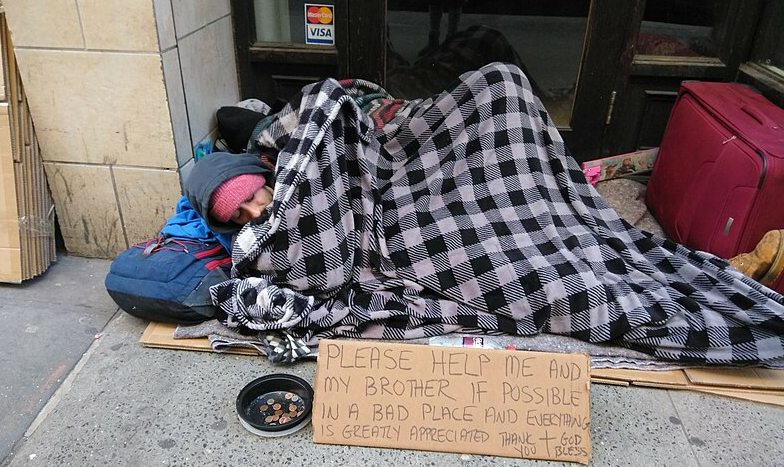The majority of children in America—a stunning 56.7 percent—are either poor or low-income with these calculations compared to 43.9 percent using the official measure.
[The Children’s Corner]
As the news cycles turn to presidential politics and primary contests, there is another story our leaders should be talking a lot about—and acting to alleviate. For millions of families there is another story: how to provide enough food and shelter and keep alive the spirit, wonder, and joy of the season for their children when resources are scarce?
Darryl and Jeanna Barrett are both college graduates who together earned about $60,000 a year. Blessed with three beautiful daughters, they survived Hurricane Katrina and bought a home in New Orleans, eager to help rebuild their city. According to Darryl, they were “on the road to the American dream.” Then he became disabled and Jeanna lost her job. Their current income—Darryl’s Social Security disability and Jeanna’s unemployment insurance—places them just barely above the official poverty level for a family of five. The Barrett girls, Anjerrica, 15, Daryanna, 10, and Jaeda, 7, would go hungry without food stamps, free school lunches, and a local food pantry.
The family recently qualified for food stamps. The Barrett girls, Anjerrica, 15, Daryanna, 10, and Jaeda, 7, would go hungry without food stamps, free school lunches, and a local food pantry. Darryl has been going to the food pantry at the nearby Community Center of St. Bernard every week and can’t say enough about how “tremendous” the center has been for them. “I called last year our $36 Christmas. That’s how much money we had in the bank. The Center made sure we had a turkey. They got a sponsor who got the girls bikes. We went to their toy drive… if it hadn’t been for them, we wouldn’t have had any Christmas,” Darryl recently told Pulitzer Prize-winning journalist Julia Cass, on assignment in New Orleans for the Children’s Defense Fund.
The economic rise and fall of the Barrett family mirrors what has happened to so many Americans who were moving up into the middle class but fell backwards in the past few years. The Barretts’ hard times resulted from the double whammy of disability and recession. Darryl graduated from Loyola University with a degree in computer systems. He worked for a casino company linking up statewide games in casinos around the state. But when he injured his back and a disc in his neck while moving a heavy piece of furniture, pressure from the disc injury severely damaged the nerves in his arms. Two years of physical therapy and a surgery failed to restore the use of his arms and he was approved for Social Security disability payments of $1550 per month.
Meanwhile, Jeanna graduated from Xavier University with a degree in chemistry. She worked as a pharmacy technician and science teacher in a Catholic school before going to work at a non-profit organization providing after-school and summer programs for low-income children in 2004. But she lost her job when the program lost state funding in 2010. In October 2011, Jeanna got what she calls a “part-time part-time” job—working at a cell phone company two days a week, three hours a day at $8 an hour. “Of all my applications, this was the only place that wanted to hire me,” she says. But the Barretts know this job is not even a short-term solution to their tough financial problems.
Sadly, the Barrett children were in the majority this year. In November, the Census Bureau released its first report using a new way of measuring poverty in America: the Supplemental Poverty Measure. This new measure won’t replace the official poverty measure but it’s an important tool to give us a more nuanced picture of poverty today.
The Supplemental Poverty Measure monitors common household expenses including food, clothing, shelter, and utilities and adjusts for regional differences. Income calculations include the value of federal nutrition programs, tax breaks like the Earned Income Tax Credit, and housing subsidies but subtract taxes paid, work and child care expenses, medical expenses, and child support payments. These more detailed calculations yielded some surprising results.
The majority of children in America—a stunning 56.7 percent—are either poor or low-income with these calculations compared to 43.9 percent using the official measure. While there is a substantial rise in the number of children considered low-income, the child poverty rate itself was actually lower using the new measure. This is important because it shows the effectiveness of key programs in lifting children out of poverty especially child and family nutrition programs, housing subsidies, and the Earned Income Tax Credit. These programs had the largest positive impact on children’s lives.
Now that we know the majority of children in America are at risk—including families like the Barretts—and need a lot of help right now to stay afloat, we must act. The details the Supplemental Poverty Measure captures give us a fuller picture of poverty’s reach during these perilous economic times and should serve as a road map to help our leaders and policymakers see what’s helping and what’s hurting.
The proof of effectiveness of crucial safety net investments shows the wisdom of expanding refundable tax credits and nutrition programs to stave off widespread hunger. All of us must urge our legislators right now to make the right choices with our tax dollars and use them to benefit the majority of our children struggling to survive and thrive on too little rather than non-needy powerful special interests.
Marian Wright Edelman is President of the Children’s Defense Fund











